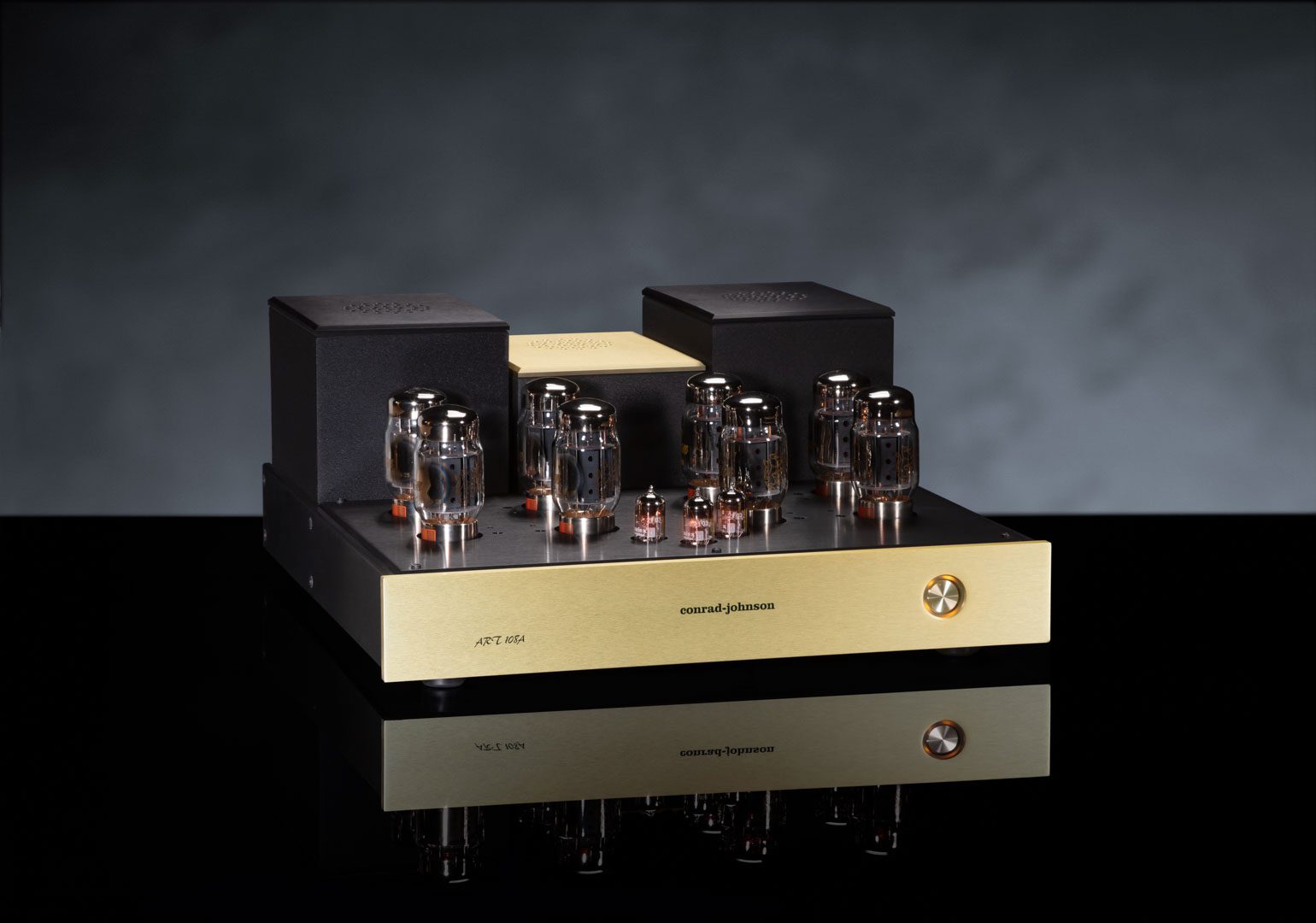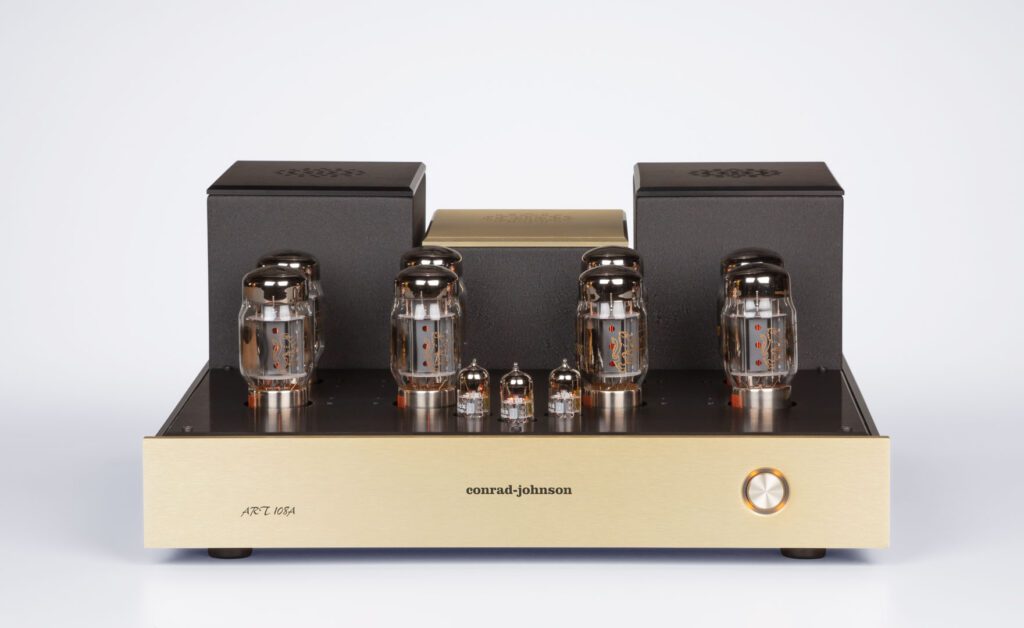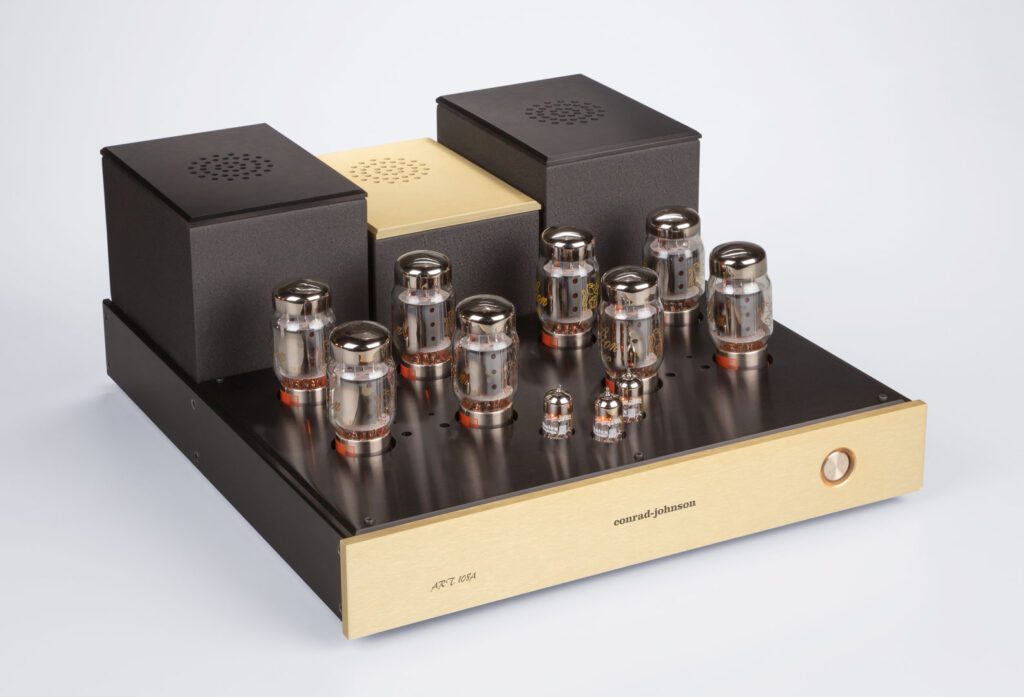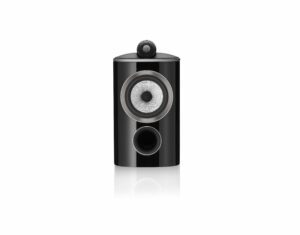
Bill Conrad and Lew Johnson searched for a long time before they discovered and settled on a general design solution that gave their stereo and mono power amplifiers what they felt were desirable virtues for real life, state-of-the-art sonic performance – this involved the circuit, the underlying concept itself (pentode or triode coupled), class of operation (AB or A) and, most importantly a wide variety of power outputs from 50 to 300W per channel.
Jeff Fischel, current owner and president of conrad-johnson design, inc. saw no need to change much in the aforementioned approach, but has worked very hard since acquiring the company towards significant new solutions and improvements in every single category of design, production and manufacturing. The ultimate proof of the pudding is the new flagship ART108A Class A Triode Mono amplifier and its, no less interesting, but somewhat less power gifted sibling, the ART27A Class A Triode Stereo amplifier (reviewed in issue 183).
A Sensitive Soul
When asked about the thinking behind these amplifiers, Jeff Fischel said how he wanted to cater for a wide variety of loudspeakers available today, and their sensitivity covering a field as wide as from 86db to 104dB. Other considerations, including different room sizes around the world and the broad shift from ‘man cave’ to ‘shared listening space’ for many listeners, were also taken into consideration. His solution was to design a circuit that would provide the same highest quality sound, use same input and power valves (in different quantities depending on the model), same very best c-j mains and output transformers and generously specified accompanying power supply sections.
ART108A monoblocks have, in essence, a circuit which is designed to operate in pukka Class A using the (arguably today’s best) Genelex Gold Lion KT88 output valves configured as triode devices. In practical terms, this means one pair of KT88s will yield clean 36 Watts of Class A power (more than enough for systems using high sensitivity loudspeakers), while the ART108A mono gives an impressive 160 Watts drawn from four pairs (eight valves in total) of KT88s without being pushed near or over any dangerous limits of distortion, overheating or demise no matter how hard driven.
There is a recent tendency for valve amp designers to go ‘a bit zeitgeisty’ in choosing whatever is the latest in a string of new power valve releases. However, I applaud conrad‑johnson for taking the ‘tried and trusted’ route with the KT88; the ‘on trend’ valves might get the column inches but might not prove to be a good sonic ‘fit’ for the brand or its loyal followers.

In today’s market, a pair of ART108A mono power amplifiers delivering 2×160W of unadulterated Class A power means you can use them with virtually any modern high-end loudspeaker of your choice! As with all best c-j products, each ART108A monoblock has separate power supply stages for the input (driver) and output (power) sections of the design. Not only that, multiple and separate regulation is present for both input and inverter stages as a bonus.
Active and passive commitment
conrad-johnson’s decades of commitment to very best passive and active components for their products continues to this day. Precision, laser-trimmed bulk metal foil Vishay resistors (ordered from their makers to specific values designs and circuits dictate) are implemented in all crucial positions both in power supplies and voltage gain audio stages. c-j proprietary PTFE (Teflon) dielectric capacitors can be found all over the place – both to couple the inverter stage to the output stage, as well as to bypass the high value (also proprietary) PP (polypropylene) capacitors in the fully regulated power supplies. Special, customised proprietary, wide bandwidth Translinear output transformers (additionally optimised for Class A operation), sit between the output stage and the Cardas Audio loudspeaker terminal block on the rear panel of each monoblock.
All internal wiring and other machined OFC connector have been selected for sonic performance. The elegant and attractive open view layout of the chassis and encapsulating metalwork make the ART108A an object that is nice to look at and have in a living or music room of every home interior. Each ART108A mono power amplifier weighs 40kg and is shipped and delivered in a custom designed wooden crate.
Care and feeding
Installation and setup is straightforward and simple in the tradition of all conrad-johnson amplifiers over the past (almost) 50 years. Each output valve is individually biased and the process has become even easier than before, thanks to bi-coloured LEDs next to each of the output valves. Our recommended biasing procedure may differ somewhat to that preached by the manufacturer, but we feel it gives equally accurate final bias setting plus one big bonus for every audiophile – an opportunity to, actually, hear the sonic difference between an incorrectly (underbiased) and correctly biased device.
So, after installing all the valves, make sure each of the bias adjustment potentiometers is at its minimum (fully anti clockwise) position. Switch the mono amplifiers on (preamplifier first with muted outputs), let them warm up for 30-60 seconds and then play some of your favourite music at moderate level for 30-40 minutes. Leave the volume control on the preamplifier where it was (mute the outputs or, if no ‘mute’ function available, select an unused input position on the selector) and start turning each of the bias potentiometers slowly clockwise until the accompanying LED glows yellow/amber. Now move to the next valve, and repeat the process until all eight power tubes have been biased correctly. You will feel more heat dissipated from each of the 16 KT88s in two monoblocks as you go along, but that is fine and perfectly normal; this is, after all, a true Class A mode of operation and when biased, to retain linearity, Class A gives off a lot of heat!

Regardless, once biasing is done, put the same piece of music you were listening to at the beginning and play it back at the same level as before. Brace yourself for an ear opening (and pleasant) surprise.
Long live the KT88!
The expected lifetime of KT88s is at least 2,500 hours when correctly biased and re-biased (once every six months or so with moderate regular use) which is a very long time. Small driver valves have at least as much life in them, too. It may sound obvious, but don’t keep the amplifier on at all times or longer than required – aside from the energy it will consume in the process, you’ll be tearing through your valves’ lifespan and Class A operation develops heat and heat has its own side effects by default. Once all the c-j Teflon capacitors have conditioned themselves to full potential (also to be achieved by normal listening procedures and stints, no more), ART108A monoblock will come to full song within 45-60 minutes from start up and, sound utterly acceptable from cold. It’s only if you don’t play music for months on end that the capacitors might lose some of that conditioning, and even that’s debatable.
In order to ensure optimum conditions, I chose to use the c-j flagship line stage GAT Series 2 as the ART108As natural partner and both digital (CD and streaming) and analogue (LP) sources were used during critical listening sessions in a reference-standard audio system, culminating in a pair of Wilson Audio Alexx V loudspeakers.
Of course, other high-grade audio products are available, many of which will be a good match and there’s no secret handshake between these products that precludes using good devices from other brands. However, the optimal word is ‘good’; you need something that delivers the sort of performance that befits an amplifier of the ART108A’s sonic gravitas, and – when it comes to preamplifiers – the number that make the cut is vanishingly small. You could spend a lifetime and a King’s ransom trying every preamp on the circuit and conclude that you should have just gone with the GAT Series 2.
Sonic Signature
I feel the ART27A (tested in Issue 183) was a pivotal product in conrad-johnson’s development. It showed the brand the sonic benefit of the smaller amp’s ‘realistic musical precision’ and the challenge was to scale that up without sacrificing either this new found subtlety or the sort of impact and dynamic range that bigger amps provide. And the ART108A more than rise to that challenge; they deliver the scale and slam needed to drive big high-performance tower loudspeakers to ‘fun’ levels while retaining much of the grace, speed and precision of the smaller stereo amplifier. The conjoining of those two hitherto disparate elements is uncanny. Yes, in absolute terms, the bigger amps are directed more at ‘scale’ than the ‘pace’ of the smaller model, but these are more shades than brightly painted distinctions.
This applied pretty much universally, irrespective of the recording you played through the system. For example, I played Boris Blank’s Electrified [Polydor], both at relatively low volume and at ‘reasonable’ sub-party volume levels. This was a fine test of the amplifier because tonally it didn’t change across the volume range; a sign of quality because playing at low levels is often an uneven experience. The bass is the true bellwether here; it neither goes ‘light’ at low levels or ‘flappy’ at high power output. I’d argue that the c-j amps are more Boris Blank and less The Prodigy in terms of sheer pace, but even here the c-j scores better than many of its predecessors and is closer to a solid-state amp in pace terms by comparison.
There’s more to life than electronica, however, but everything was so adept when played through the ART108A, any list of tracks is more like showing off the depth of your music collection. If we are showing off, Orange, by Caroline Shaw and the Attacca Quartet [Nonesuch] scores many ‘cred’ points; this modern string quartet arrangement is difficult at times and always a challenging listen, but the rewards are great here. There is a tendency for these close-mic’d instruments to sound a little hard and grating, often more so than required by the music. The ART108A amps get past that close-quarters recording and get under its skin. You sit and listen to the performance as a work of great texture and beauty for a modern composition; still edgy and ‘angular’ at times, but impassioned and textured. The refinement and ‘right’ balance (both in tone and staging qualities) that were always c-j watchwords are there in full effect. As with most modern conrad-johnson designs, the ART108A is less ‘warm and cuddly’ and less ‘rose-tinted’ than previous models, but it’s still romantic-sounding enough to draw you into the music.
Each track cited on my notepad had an ‘Aha!’ by it. Meaning I’ve either turned into Alan Partridge (it’s a distinct possibility, I have dismantled more than my share of Corby Trouser Presses) or each successive track I played was a revelation. Whether it was the power of Schiff’s piano playing [Beethoven Piano Sonatas, ECM] or the interplay of musicians on Cannonball Adderley’s Somethin’ Else [Blue Note], these are all albums that have been played by me extensively and each one gave up a few more secrets through the ART108A. It’s heady, exciting stuff.
Listening anew
The conrad-johnson ART108A amps are capable of making you listen to your recordings as if they were new to you. In absolute terms, no ‘hollow-state’ power amplifier can fully compete with the detail extraction and sheer grip the very best solid-state amps can impart on the sound, but similarly no solid-state amp can deliver the grace, richness and refinement on offer here. That doesn’t sound like a trade-off or a compromise to me; it sounds like the ART108A delivers its own slice of sonic perfection, one that many people will want to replicate in their own systems.
The conrad-johnson ART108A is more than the brand’s latest statement piece amplifier. It’s like the subtle and delicate ART27A meeting the power and detail of some of the brand’s classic Premier series flagship power amps. That’s a combination that really gets under your skin.
Technical specifications
- Type Mono valve power amplifier
- Power 160 Watts rms both channels driven into 4 ohms from 30 to 15KHz at no more than 1.5% total harmonic distortion
- Tube Complement 3 × 6922, 8 × KT88
- Sensitivity 1.0V rms to rated power
- Small Signal Distortion less than 0.25% at mid-band
- Frequency Response 20 Hz to 20 kHz, ± 0.25 dB
- Hum and Noise less than 200 microVolts
- Phase phase correct
- Input Impedance 100 kOhms
- Dimensions (W×H×D) 48 × 22 × 53cm each
- Weight 40.4kg each
- Price £48,000 per pair
Manufactured by
conrad-johnson design, inc.
Distributed in the UK by
Audiofreaks
+44(0)208 948 4153
By Alan Sircom
More articles from this authorRead Next From Review
See all
PrimaLuna EVO 100 phono preamplifier
- Apr 22, 2024

Reiki Audio SuperSwitch Master Pro + Servant Pro
- Mar 27, 2024

Melco Audio N1-S38 music server
- Mar 27, 2024











